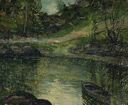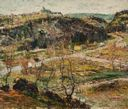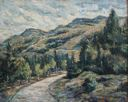Ernest Lawson
American
(Halifax, Nova Scotia, 1873 - 1939, Miami Beach, Florida)
Only ten years separate the first exhibition of the group of American Impressionists known as The Ten (1898) from the inaugural show of their realist successors, The Eight (1908). Painter Ernest Lawson is an important link between the two groups and their different approaches to painting. As a student of Julian Alden Weir (1852–1919) and John Henry Twachtman (1853–1902), Lawson developed a style that was heavily indebted to Impressionism; however, his close friendship with William Glackens (1870–1938) led him to join The Eight and to participate in their groundbreaking exhibition at the Macbeth Galleries in New York.
Adventurous and peripatetic, Lawson benefited from his exposure to a wide variety of art over the course of his life. He was born in Halifax, Nova Scotia, but soon began to wander. His youthful experiences included working for a textile designer at the Kansas City Art Institute and as a draftsman for an engineering firm in Mexico City. He acquired formal art training at the Art Students League in New York and at the Académie Julian in Paris.
Lawson received his most important training from Weir and Twachtman, the latter being the instructor he admired most. He worked with both men in the summer of 1892 at Cos Cob, Connecticut, and he later met Impressionist Alfred Sisley, (1839–1899) in France. These artists shaped his technique, teaching him to paint with the short, choppy, broken strokes of Impressionism. Lawson then developed his own response to landscape by adopting high-keyed, brilliant color to reproduce the effect of sparkling light. His paint surfaces vary in density, the pigments applied not only with brushes but also with palette knives and occasionally his fingers.
In 1898 Lawson and his family settled in Washington Heights, a neighborhood at the upper reaches of Manhattan. They lived there for the next eight years, and Lawson’s paintings from this period almost exclusively depict the local landscape. After moving to Greenwich Village in 1906, Lawson also began to paint the scenic areas on the rivers that surround and connect parts of the city, including the river traffic and the distinctive architecture of bridges.
Excerpted from "American Paintings from the Montgomery Museum of Fine Arts," 2006, page 142, catalogue number 55.
American
(Halifax, Nova Scotia, 1873 - 1939, Miami Beach, Florida)
Only ten years separate the first exhibition of the group of American Impressionists known as The Ten (1898) from the inaugural show of their realist successors, The Eight (1908). Painter Ernest Lawson is an important link between the two groups and their different approaches to painting. As a student of Julian Alden Weir (1852–1919) and John Henry Twachtman (1853–1902), Lawson developed a style that was heavily indebted to Impressionism; however, his close friendship with William Glackens (1870–1938) led him to join The Eight and to participate in their groundbreaking exhibition at the Macbeth Galleries in New York.
Adventurous and peripatetic, Lawson benefited from his exposure to a wide variety of art over the course of his life. He was born in Halifax, Nova Scotia, but soon began to wander. His youthful experiences included working for a textile designer at the Kansas City Art Institute and as a draftsman for an engineering firm in Mexico City. He acquired formal art training at the Art Students League in New York and at the Académie Julian in Paris.
Lawson received his most important training from Weir and Twachtman, the latter being the instructor he admired most. He worked with both men in the summer of 1892 at Cos Cob, Connecticut, and he later met Impressionist Alfred Sisley, (1839–1899) in France. These artists shaped his technique, teaching him to paint with the short, choppy, broken strokes of Impressionism. Lawson then developed his own response to landscape by adopting high-keyed, brilliant color to reproduce the effect of sparkling light. His paint surfaces vary in density, the pigments applied not only with brushes but also with palette knives and occasionally his fingers.
In 1898 Lawson and his family settled in Washington Heights, a neighborhood at the upper reaches of Manhattan. They lived there for the next eight years, and Lawson’s paintings from this period almost exclusively depict the local landscape. After moving to Greenwich Village in 1906, Lawson also began to paint the scenic areas on the rivers that surround and connect parts of the city, including the river traffic and the distinctive architecture of bridges.
Excerpted from "American Paintings from the Montgomery Museum of Fine Arts," 2006, page 142, catalogue number 55.


